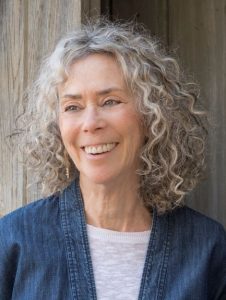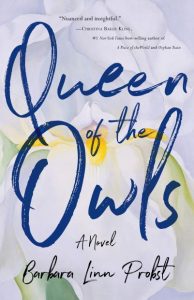Interview With Barbara Probst

Barbara Probst’s novel QUEEN OF THE OWLS (April 2020) is the powerful story of a woman’s search for wholeness, framed around the art and life of iconic painter Georgia O’Keeffe. QUEEN OF THE OWLS has been selected as one of the 20 most anticipated books of 2020 by Working Mother and will be the May 2020 selection for the Pulpwood Queens, a network of nearly 800 book clubs across the U.S.
We are delighted to share this interview with Barbara!
How did your childhood impact the writer you’ve become?
I grew up in place and era when kids were left alone to “go out and play.” My parents didn’t consider it their job to entertain us and we hardly ever turned on the TV, so my sister and I made our own dollhouses and doll furniture out of odds and ends, created our own newspaper, put on plays we’d invented. I remember making up stories as I poked around in the leaves or built kingdoms in the sand—daydreaming in an old swivel chair on the screened porch—running through the partly-constructed house next door, pretending that the beams and girders were trees, enemy soldiers, spies. My mother would have been appalled at the danger and ordered us not to play there, but she didn’t know because we weren’t supervised the way kids are now.
When did you decide you wanted to be a writer?
I wrote my first “book” when I was seven, in a tiny spiral-bound notebook with a black cover, complete with illustrations. It was called At Home With Us. I still have it, in fact!
How has writing changed you as a person?
I always wrote, but for many years it was non-fiction. As a clinician and advocate for out-of-the-box kids, I wrote newsletter articles and a book for parents called When the Labels Don’t Fit. Later, as a social work professor, I wrote more scholarly articles than I care to remember, along with a clinical textbook. I felt comfortable in that kind of writing because it allowed me to be an “expert.” I had knowledge, firm ground beneath my feet.
It was the switch to fiction that changed me. It meant giving up the security of a style of writing I knew I was good at and becoming a beginner again.
Writing fiction means writing about what it means to be human—the messiness and complexity of imperfect but struggling people, just like me. To write fiction that truly speaks to others, you have to open, embrace, accept. That meant developing an emotional intelligence to balance the cerebral one I’d cultivated so well over the years.
Writing stories made me to go deeper, trust something more intuitive—and take risks. It made me vulnerable in a way I wasn’t used to. Because of that, I think I’m freer, braver, and more generous than I was before.
Can you tell us a bit about QUEEN OF THE OWLS? What inspired you to write it?
Queen of the Owls is the story of a woman’s quest to claim her neglected sensuality and find her true self hidden behind the roles of wife, mother, sister, and colleague.
I wanted to tell a story that women of all ages and backgrounds could connect with—about the deep yearning we all feel to be our truest selves, to reclaim whatever part of ourselves we’ve neglected or denied. Not at the expense of the roles we fill, but behind them.
The idea of framing the story around the art and life of Georgia O’Keeffe simply “appeared” to me. I’ve always loved her paintings. They called to me in a way that felt very connected to the question of what it means to be a woman. In doing research for the book, I learned so much more about her life and work—all of which enhanced the book in ways I hadn’t anticipated. It also turned out that photography worked well as a vehicle for the story, because it’s about Elizabeth’s yearning to be truly seen.
Queen of the Owls also deals with a number of issues that are high on the public consciousness. Among them are the meaning of “consent,” the polarization of women into bodies and brains, and the search for self at a time when notions of the “feminine” and the “female” are in flux.
As for why I chose to write about these issues—it would be disingenuous to claim that it was simply because of their moral and political importance. While these issues are deeply compelling, they’re also deeply personal. Like Elizabeth, I was always pegged as a “brain,” and it’s taken me a long time to integrate the “owl” and the “fox” within myself.
What would be your 6 word memoir?
Risk. Give generously. Let go. Transform.
What is the best writing advice you’ve ever had, and the worst?
That’s one of those hard-to-answer questions, because I’ve been fortunate to have received so much good advice from so many wise and generous mentors! But if I have to pick one, I’d say that it was Sandra Scofield’s injunction to make each character worthy of love and respect. I had a tendency, early on, to make my heroines too angry or full of self-pity. I suppose I thought that made them “complex” or “interesting.” But Sandra helped me to humanize and care about my characters, which is the only way to make readers feel that way too.
Worst advice? All those formulas, rules, and grids that tell you what has to happen at the one-quarter mark or halfway mark or in the first fifty pages. They kill the life of a story. That’s not to say that a story doesn’t need tension, emotional turning points, dark moments, and all of that. Of course it does! But if you’re so busy trying make it conform to a recipe, you’ll never be able to hear the voice of the story.
What is your writing process like? Are you a pantser or a plotter?
I’m somewhere in-between. I need to have an overall map, for sure, and I spend a lot time thinking, analyzing, and writing out what I’d call the “bones” of the story. But then, during the actual writing, those bones become very porous and flexible. Something entirely new will inevitably present itself, once I’m immersed in the story—in fact, that’s how the best elements appear! They can’t be known in advance, before one has begun to live and breathe along with the characters.
It’s like the advice someone once gave me, before I left on a long trip. He said, “Be very well-planned, but ready to drop your plans in an instant.”
Do you need a special place to write?
I have the luxury of my own office, with a desk that overlooks a peaceful landscape of trees and hills. I work best in a Zen-like environment, no noise, no clutter—I even have a glass-topped desk! On the other hand, I also do a lot of writing on the train. I think the white noise and lack of interruption creates a kind of cocoon that lets me focus.
Are you part of a writing community or a writing group?
I belong to several online communities including the Women’s Fiction Writers Association, Writer Unboxed, the She Writes Press community, and the 2020 Debut Authors. They’re invaluable ways to exchange ideas and offer support.
What is your experience with social media as a writer? Do you find it distracts you or does it provide inspiration?
I avoided all social media until about a year ago, when I knew I’d have to take the plunge if I wanted to interact with readers—and it’s been very helpful that way, for sure. But I have to admit that I find it very distracting and addictive. Everything is so fast and reactive. I already have a very fast tempo, so what I need are ways to slow down.
Who are your favorite authors?
Another question I hate, because it’s so difficult to choose! But here are a few: Anne Tyler, Sue Miller, Elizabeth Berg, Jenna Blum, Julia Glass, Gail Godwin, Beth Gutcheon, Alice Munro.
What are you reading currently?
I’ve just finished a gorgeous book by another She Writes Press author, Ellen Notbohm, called The River by Starligh, and am just about to start Ask Again, Yes by Mary Beth Keane.
—
BARBARA LINN PROBST is a writer of both fiction and non-fiction, living on an historic dirt road in New York’s Hudson Valley. Her debut novel QUEEN OF THE OWLS (April 2020) is the powerful story of a woman’s search for wholeness, framed around the art and life of iconic painter Georgia O’Keeffe. QUEEN OF THE OWLS has been selected as one of the 20 most anticipated books of 2020 by Working Mother and will be the May 2020 selection for the Pulpwood Queens, a network of nearly 800 book clubs across the U.S. Her second novel, THE SOUND BETWEEN THE NOTES, will be published in April 2021. In her spare time, Barbara blogs for several award-winning sites for writers and is a serious amateur pianist. To learn more, please see www.BarbaraLinnProbst.com
QUEEN OF THE OWLS
 A chance meeting with a charismatic photographer will forever change Elizabeth’s life.
A chance meeting with a charismatic photographer will forever change Elizabeth’s life.
Until she met Richard, Elizabeth’s relationship with Georgia O’Keeffe and her little-known Hawaii paintings was purely academic. Now it’s personal. Richard tells Elizabeth that the only way she can truly understand O’Keeffe isn’t with her mind―it’s by getting into O’Keeffe’s skin and reenacting her famous nude photos.
In the intimacy of Richard’s studio, Elizabeth experiences a new, intoxicating abandon and fullness. It never occurs to her that the photographs might be made public, especially without her consent. Desperate to avoid exposure―she’s a rising star in the academic world and the mother of young children―Elizabeth demands that Richard dismantle the exhibit. But he refuses. The pictures are his art. His property, not hers.
As word of the photos spreads, Elizabeth unwittingly becomes a feminist heroine to her students, who misunderstand her motives in posing. To the university, however, her actions are a public scandal. To her husband, they’re a public humiliation. Yet Richard has reawakened an awareness that’s haunted Elizabeth since she was a child―the truth that cerebral knowledge will never be enough.
Now she must face the question: How much is she willing to risk to be truly seen and known?
Recipient of stellar advance praise from best-selling authors:
“A nuanced, insightful, culturally relevant investigation of one woman’s personal and artistic awakening, Queen of the Owls limns the distance between artist and muse, creator and critic, concealment and exposure.”
―Christina Baker Kline, #1 New York Times best-selling author of A Piece of the World and Orphan Train
“This is a stunner about the true cost of creativity, and about what it means to be really seen. Gorgeously written and so, so smart (and how can you resist any novel that has Georgia O’Keeffe in it?), Probst’s novel is a work of art in itself.”
―Caroline Leavitt, best-selling author of Pictures of You, Is This Tomorrow and Cruel Beautiful World
“Readers will root for Elizabeth―and wince in amusement at her pratfalls―as she strikes out in improbable new directions … An entertaining, psychologically rich story of a sometimes giddy, sometimes painful awakening.” ―Kirkus Reviews
Category: Contemporary Women Writers, Interviews, On Writing
























